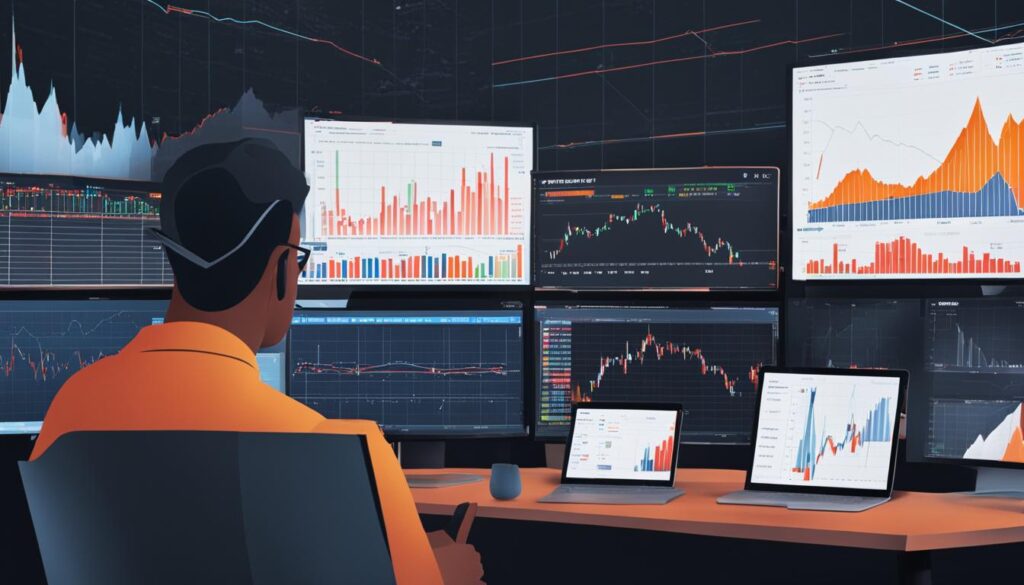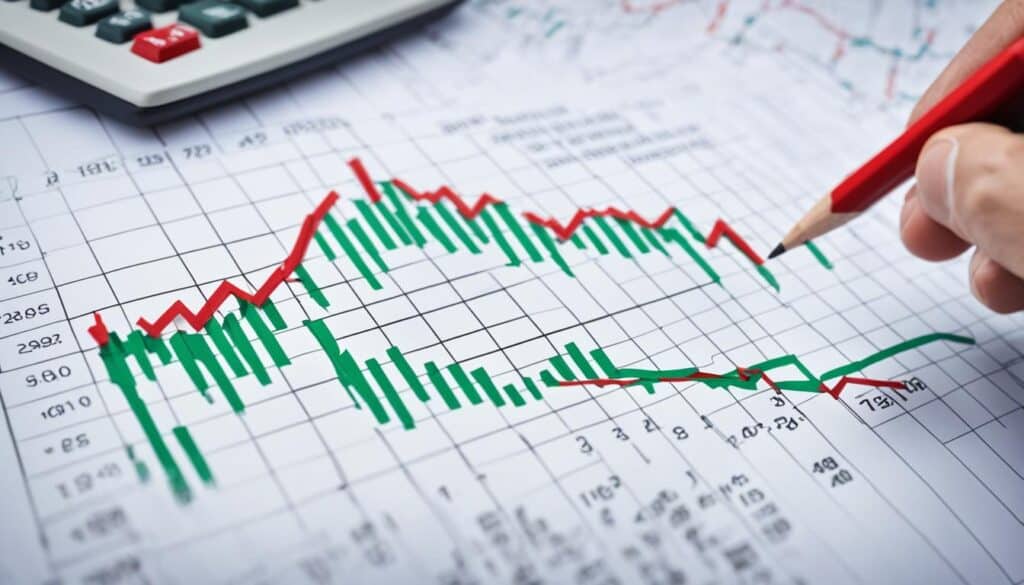In today’s dynamic and ever-changing financial markets, traders are constantly seeking strategies to navigate market volatility and capitalize on investment opportunities. One asset class that has gained significant popularity in recent years is Exchange-Traded Funds (ETFs). These investment vehicles offer traders exposure to diverse portfolios of assets while providing the flexibility and liquidity of trading on an exchange.
Understanding how to effectively trade ETFs during periods of market volatility is crucial for traders looking to enhance their investment strategies. By implementing specific techniques and strategies tailored to volatile market conditions, traders can mitigate risks and capitalize on potential price movements.
In this article, I will explore various strategies that traders can employ when trading ETFs in volatile markets. I will discuss the impact of market volatility on ETF performance and liquidity, important factors to consider when trading ETFs in volatile markets, and provide key takeaways to help traders navigate these challenging market conditions.
Key Takeaways:
- ETFs provide traders with exposure to diverse portfolios of assets and flexibility of exchange trading.
- Market volatility can significantly impact ETF performance and trading volumes.
- Traders should employ well-defined strategies to manage risks and maximize returns in volatile markets.
- Consider factors such as liquidity, volatility, and market trends when trading ETFs in volatile markets.
- Stay informed, monitor market conditions, and adapt trading strategies as needed to navigate the ETF market during market volatility.
The Impact of Market Volatility on ETFs
Market volatility can have a significant impact on the performance of ETFs. During periods of heightened volatility, investors may experience increased price fluctuations and higher trading volumes. This volatility can be driven by various factors, such as economic data releases, geopolitical events, or market sentiment.
Traders need to understand how market volatility can affect ETF prices and liquidity to effectively navigate the market and make informed trading decisions.
When market volatility is high, ETF prices tend to be more volatile as well. This means that the value of an ETF can fluctuate more rapidly and unpredictably, posing both opportunities and risks for traders.
Higher trading volumes during volatile periods can also impact the liquidity of ETFs. Liquidity refers to the ability to buy or sell an ETF quickly and at a desirable price. When liquidity is low, it may be challenging to execute trades without significantly impacting the ETF’s price.
“Market volatility can create unique opportunities for ETF traders. Increased price fluctuations can lead to potential profits, while higher volumes may indicate increased market interest. However, it’s important to be mindful of the heightened risks during volatile periods.”
Traders should closely monitor market volatility indicators, such as the VIX (CBOE Volatility Index), to gauge market sentiment and assess the potential impact on ETFs. Additionally, understanding the underlying assets and composition of an ETF can provide insights into how it may be affected by market volatility.
By staying informed and adapting their trading strategies to changing market conditions, traders can position themselves to take advantage of opportunities and mitigate the risks associated with market volatility.
Table 1: Impact of Market Volatility on ETFs
| Impact | Explanation |
|---|---|
| Increased price fluctuations | ETF prices can experience larger and more frequent price swings during periods of high market volatility. |
| Higher trading volumes | Volatile markets often attract increased trading activity, resulting in higher trading volumes for ETFs. |
| Changes in liquidity | Market volatility can impact the liquidity of ETFs, making it more challenging to buy or sell shares at desirable prices. |
Strategies for Trading ETFs in Volatile Markets
When trading ETFs in volatile markets, I know the importance of having a well-defined strategy in place to manage risks and maximize returns. Here are some effective strategies that traders like me can consider:
Diversification
One of the key strategies in trading ETFs in volatile markets is diversification. By spreading investments across different sectors or asset classes, I can reduce the impact of market fluctuations on my portfolio. Diversification helps me to minimize losses in a specific sector or asset class and increase the potential for gains in others.
Stop-Loss Orders
Implementing stop-loss orders is another useful strategy for trading ETFs in volatile markets. By setting a specific price at which I am willing to sell my ETF shares, I can limit potential losses and protect my capital. Stop-loss orders allow me to automate the sell process in case the ETF’s price falls below a predetermined threshold.
Technical Analysis
Using technical analysis techniques can help me identify patterns and trends in ETF price movements. By studying charts, indicators, and other technical tools, I can make more informed trading decisions. Technical analysis provides valuable insights into support and resistance levels, entry and exit points, and potential price reversals.
Active Monitoring
Active monitoring of the ETF market is crucial during volatile periods. By staying informed about significant market events, economic data releases, and geopolitical developments, I can anticipate potential fluctuations and adjust my trading strategy accordingly. Regularly monitoring news, market trends, and ETF performance allows me to react quickly to changing market conditions.
| Strategy | Description |
|---|---|
| Diversification | Spreading investments across different sectors or asset classes to reduce risk |
| Stop-Loss Orders | Setting predetermined sell prices to limit potential losses |
| Technical Analysis | Using charts and indicators to analyze price patterns and trends |
| Active Monitoring | Staying informed about market events and adjusting strategies accordingly |
By employing these strategies, traders like me can better navigate the challenges of trading ETFs in volatile markets. It is important to remember that no strategy guarantees success, and it is essential to continuously evaluate and adapt strategies to evolving market conditions.
Factors to Consider When Trading ETFs in Volatile Markets
When trading ETFs in volatile markets, there are several important factors that traders should consider in order to make informed decisions. These factors can help individuals navigate the uncertain and rapidly changing landscape of volatile markets, ultimately increasing their chances of success.
1. Market Volatility
The first factor to consider is the level of market volatility. Volatile markets experience sharp price fluctuations and increased trading volumes, which can present both opportunities and risks for ETF traders. It is crucial to analyze the current volatility levels and understand how it may impact the performance of the ETFs you are considering trading.
2. Liquidity
Liquidity is another important factor to evaluate when trading ETFs in volatile markets. Liquidity refers to the ease with which an ETF can be bought or sold without causing significant price changes. In periods of market volatility, liquidity can dry up, making it challenging to enter or exit positions at desired prices. Traders should assess the liquidity of the ETFs they plan to trade and consider the potential impact on their ability to execute trades efficiently.
3. Risk Management
Effective risk management is crucial when trading ETFs in volatile markets. Traders should have a well-defined risk management strategy that includes setting stop-loss orders, diversifying their portfolios, and using appropriate position sizing techniques. By managing risk effectively, traders can protect their capital and minimize potential losses during periods of market turbulence.
4. Fundamental Analysis
Conducting thorough fundamental analysis is essential when trading ETFs in volatile markets. Traders should analyze the underlying assets or sectors represented by the ETFs and evaluate any potential factors that may impact their performance. This analysis can include assessing economic indicators, corporate earnings reports, geopolitical events, and market sentiment. By understanding the fundamental drivers of the ETFs, traders can make more informed decisions and position themselves strategically.
| Factors to Consider When Trading ETFs in Volatile Markets | Key Takeaways |
|---|---|
| Market Volatility | Assess current volatility levels and understand its impact on ETF performance. |
| Liquidity | Evaluate ETF liquidity to ensure efficient execution of trades. |
| Risk Management | Implement effective risk management strategies to protect capital. |
| Fundamental Analysis | Conduct thorough analysis of underlying assets and factors impacting performance. |
5. Technical Analysis
In addition to fundamental analysis, traders should also incorporate technical analysis techniques when trading ETFs in volatile markets. Technical analysis involves studying historical price and volume data to identify trends, patterns, and potential entry or exit points. Utilizing technical indicators and chart patterns can assist traders in making timely and profitable trading decisions.
6. Stay Informed
It is crucial to stay informed about current market news, events, and trends when trading ETFs in volatile markets. Traders should regularly monitor economic indicators, corporate announcements, and any other factors that may impact the market. By staying informed, traders can adapt their strategies accordingly and take advantage of emerging opportunities.
By considering these factors and implementing appropriate strategies, traders can navigate volatile markets with greater confidence and increase their chances of success when trading ETFs.
Conclusion
Navigating the ETF market during periods of market volatility requires careful planning and execution of trading strategies. As a trader, I understand the importance of analyzing market trends and considering factors such as liquidity and volatility. By implementing effective risk management techniques, I can make more informed decisions and improve my chances of success in volatile markets.
Understanding the impact of market volatility on ETFs is key to developing a winning strategy. During periods of heightened volatility, ETF prices can experience significant fluctuations, presenting both risks and opportunities. It is crucial to stay informed about economic data releases, geopolitical events, and market sentiment to effectively navigate the ever-changing landscape of the ETF market.
As I trade ETFs in volatile markets, I also recognize the importance of adapting my strategies. Market conditions can shift rapidly, and it is crucial for me to stay on top of these changes. By continually monitoring market conditions and adapting my trading strategies as needed, I can stay ahead of the curve and take advantage of the opportunities presented by market volatility.
In conclusion, trading ETFs in volatile markets can be challenging yet rewarding. By analyzing market trends, considering factors such as liquidity and volatility, and implementing effective risk management techniques, I can make informed decisions and enhance my trading success. As I continue on my trading journey, I will remain vigilant, adaptable, and well-informed to navigate the dynamic world of ETFs and market volatility.
FAQ
What are ETFs?
Exchange-Traded Funds (ETFs) are investment funds that trade on stock exchanges, similar to individual stocks. They are designed to track the performance of a specific index, sector, commodity, or asset class.
How does market volatility impact ETFs?
Market volatility can significantly affect the performance of ETFs. During periods of high volatility, ETF prices can experience increased fluctuations, and trading volumes may be higher. This can be driven by economic data releases, geopolitical events, or market sentiment.
What strategies can traders use when trading ETFs in volatile markets?
Traders can employ several strategies when trading ETFs in volatile markets. These strategies include utilizing stop-loss orders, diversifying their portfolio, using limit orders to control buy and sell prices, and staying informed about market trends and news that can impact the performance of ETFs.
What factors should traders consider when trading ETFs in volatile markets?
Traders should consider several factors when trading ETFs in volatile markets. These factors include analyzing market trends, assessing the liquidity of ETFs they wish to trade, evaluating the volatility of the market, and implementing effective risk management techniques.
Source Links
- https://finance.yahoo.com/news/star-group-l-p-declares-170000433.html
- https://www.marketscreener.com/quote/commodity/WTI-2355639/news/Stock-markets-down-oil-volatility-and-US-inflation-weigh-45725404/
- https://finance.yahoo.com/news/2024-stock-market-outlook-keep-163514686.html
Disclaimer
All information on this website is of a general nature. The information is not adapted to conditions that are specific to your person or entity. The information provided can not be considered as personal, professional or legal advice or investment advice to the user.
This website and all information is intended for educational purposes only and does not give financial advice. Signal Mastermind Signals is not a service to provide legal and financial advice; any information provided here is only the personal opinion of the author (not advice or financial advice in any sense, and in the sense of any act, ordinance or law of any country) and must not be used for financial activities. Signal Mastermind Signals does not offer, operate or provide financial, brokerage, commercial or investment services and is not a financial advisor. Rather, Signal Mastermind Signals is an educational site and a platform for exchanging Forex information. Whenever information is disclosed, whether express or implied, about profit or revenue, it is not a guarantee. No method or trading system ensures that it will generate a profit, so always remember that trade can lead to a loss. Trading responsibility, whether resulting in profits or losses, is yours and you must agree not to hold Signal Mastermind Signals or other information providers that are responsible in any way whatsoever. The use of the system means that the user accepts Disclaimer and Terms of Use.
Signal Mastermind Signals is not represented as a registered investment consultant or brokerage dealer nor offers to buy or sell any of the financial instruments mentioned in the service offered.
While Signal Mastermind Signals believes that the content provided is accurate, there are no explicit or implied warranties of accuracy. The information provided is believed to be reliable; Signal Mastermind Signals does not guarantee the accuracy or completeness of the information provided. Third parties refer to Signal Mastermind Signals to provide technology and information if a third party fails, and then there is a risk that the information may be delayed or not delivered at all.
All information and comments contained on this website, including but not limited to, opinions, analyzes, news, prices, research, and general, do not constitute investment advice or an invitation to buy or sell any type of instrument. Signal Mastermind Signals assumes no responsibility for any loss or damage that may result, directly or indirectly, from the use or dependence on such information.
All information contained on this web site is a personal opinion or belief of the author. None of these data is a recommendation or financial advice in any sense, also within the meaning of any commercial act or law. Writers, publishers and affiliates of Signal Mastermind Signals are not responsible for your trading in any way.
The information and opinions contained in the site are provided for information only and for educational reasons, should never be considered as direct or indirect advice to open a trading account and / or invest money in Forex trading with any Forex company . Signal Mastermind Signals assumes no responsibility for any decisions taken by the user to create a merchant account with any of the brokers listed on this website. Anyone who decides to set up a trading account or use the services, free of charge or paid, to any of the Broker companies mentioned on this website, bears full responsibility for their actions.
Any institution that offers a service and is listed on this website, including forex brokers, financial companies and other institutions, is present only for informational purposes. All ratings, ratings, banners, reviews, or other information found for any of the above-mentioned institutions are provided in a strictly objective manner and according to the best possible reflection of the materials on the official website of the company.
Forex/CFD trading is potentially high risk and may not be suitable for all investors. The high level of leverage can work both for and against traders. Before each Forex/CFD investment, you should carefully consider your goals, past experience and risk level. The opinions and data contained on this site should not be considered as suggestions or advice for the sale or purchase of currency or other instruments. Past results do not show or guarantee future results.
Neither Signal Mastermind Signals nor its affiliates ensure the accuracy of the content provided on this Site. You explicitly agree that viewing, visiting or using this website is at your own risk.




